ISSN: 2511-7602
Journal for Art Market Studies
ISSN: 2511-7602
Journal for Art Market Studies
Gitta Ho
Under the code name “M-Aktion” (M as an abbreviation of the German word for furniture: Möbel), the German occupiers in World War II plundered the households of Jewish citizens who had fled, been interned or deported in France, Belgium and the Netherlands. In France alone, tens of thousands of apartments and houses were emptied out in the course of the M-Aktion between 1942 and 1944. Furniture and furnishings were taken to Germany where they were used, for example, as a supply for homes which had been damaged in the war. This article focuses on the art works seized as part of the looted mass of objects. Part of them, including mainly paintings and drawings, were listed separately by the Germans. While there was a plan to sell this contingent on the art market at some point, this concrete form of utilisation probably never happened. If the sale had taken place, it would certainly have been much more extensive than what might have been expected at first glance.
During the Second World War, the so-called “M-Aktion” (M as in Möbel, the German word for furniture) took place in the Nazi-occupied areas of France, Belgium and the Netherlands. This was a large-scale plundering initiative, directed at the homes of Jewish citizens who had either fled, been interned, or deported. This article will focus on the city of Paris. Even here, the number of plundered homes amounted to circa 38,000. Their contents of furniture and furnishings were removed. Between two and three hundred freight cars per week left Paris for Germany, and were often loaded at the train station at Aubervilliers north of the French capital (fig. 1). While the initial plan had been to use the furniture plundered from 1942 for the furnishing of newly founded administration offices in the conquered Eastern territories, these pieces were later used to replenish the contents of bombed-out homes in Western Germany, amongst other purposes.1
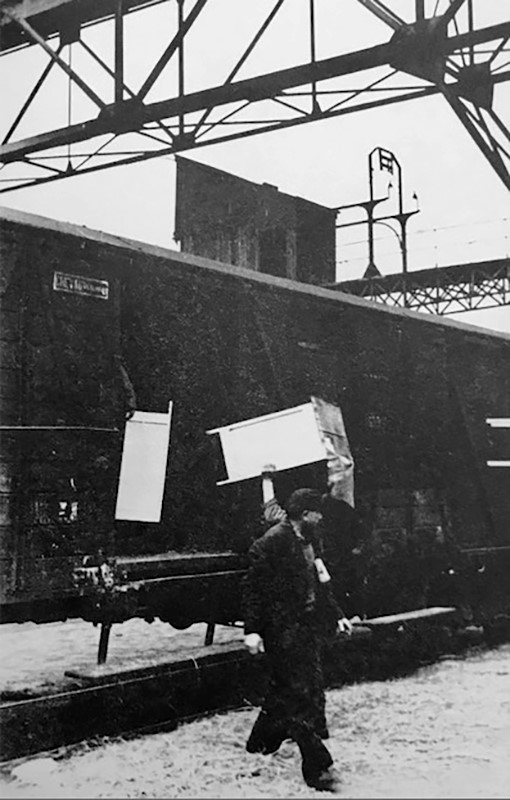
Fig. 1: Anonymous photographer, Furniture loaded onto a rail car at Aubervilliers in order to be shipped to Germany, c. 1943/1944, photography
Bundesarchiv, Koblenz, B323/311, fol. 0017
When objects in the M-Aktion loot were deemed to have intrinsic artistic value, these were recorded separately and not taken to Germany immediately but initially retained in France. After a revaluation, part of these were designated for a later sale. There were over 320 such objects in the M-Aktion that were intended for the trade. Their descriptions survive, for example on inventory lists or index cards.2 As a separate group, they give rise to a number of questions. Which criteria were used to select the works for the art trade? What were the paths of the plundered objects? How, and with the help of which dealers, were they to be put on the art market? To anticipate one results of this study: was the entire sale in fact intended to allow other art works to be slipped into the trade that came from entirely unrelated looting activities?
Research on objects confiscated in the course of the M-Aktion is significantly impeded by the lack of sources. When the Paris head office of the Dienststelle Westen, the office in charge of the M-Aktion, was vacated just before the end of the German occupation of France in August 1944, the archives were consigned to the flames. A subsequently written report of the Dienststelle about the office liquidation gave an overview of the destroyed documentation.3 According to this, it had consisted of files relating to the homes emptied in the course of the M-Aktion, to the shipping of plundered objects, to pieces of furniture and other objects that were shipped separately, as well as general correspondence. Furthermore, the entire process of plunder had been designed from the outset in such a way as to leave very few traces. “The confiscation of Jewish home contents should attract as little attention as possible”, was the first item on a list of instructions sent on 8 February 1942 to the military commander in France.4
In spite of all the documentation and information which was destroyed or not even recorded in the first place, the process of plundering was documented and largely followed an established pattern. First of all, an employee of the Dienststelle Westen obtained access to the home, assisted by an interpreter who communicated with the concierge who held the keys. An initial report with a very general assessment of the furnishings in each of the rooms was produced. While the flat remained sealed, the removal of the contents was arranged for a few weeks later, which was documented in another “removal” report.5 The lorries used to remove the plundered pieces were driven to various warehouse facilities, including for example the Bassano facility near the Arc de Triomphe in Paris, and the “East depot” near today’s site of the Bibliothèque Nationale in the 13th arrondissement. Here, the incoming boxes were unpacked and their content sorted by Jewish internees. If objects were identified as art works “suitable for economic utilisation”, they were passed over to the employees of the Reichsleiter Rosenberg Taskforce (Einsatzstab Reichsleiter Rosenberg, ERR). They were brought to the Jeu de Paume exhibition centre and to some rooms in the Louvre where they were inventoried and stored.
Soon after the beginning of the occupation in June 1940, the confiscation of Jewish art assets had begun in Paris, initially focused on well-known art collections as those of the Rothschild family, David David-Weill, and Alphonse Kann. The German embassy in Paris and its ambassador Otto Abetz played a significant role in these lootings. Officially initiated in order to prevent works of art from being exported abroad and thus “protect” them, the Germans began to covet especially the Old Master paintings. Many of them became part of Hermann Göring’s ambitiously accumulated art collection, or of the collection for Adolf Hitler’s museum project in Linz. While there had initially been disputes among the Germans about the responsibilities for the confiscation of the great art collections, the ERR under Alfred Rosenberg was eventually given overall control of the plunder. At first, the M-Aktion was also organised by the ERR. It was only in April 1942 that the responsibility was passed to a specially designated office for the M-Aktion activities, the so-called Dienststelle Westen. It was headed by Kurt von Behr, who referred to himself as the “inventor” of the M-Aktion and who had previously run the special task force for fine art that handled the administration of the art work collection points in the Louvre and in the Jeu de Paume.
The M-Aktion remained active in France until August 1944, that is even after the beginning of the Allied Operation Overlord which culminated in the successful liberation of Paris. In its final month, an overall report about its work was sent to Germany, giving a full picture of the vicious effectiveness of the large-scale confiscations, whose head office in Paris was supported by branches such as in Bordeaux and Nancy.6 The final report lists in meticulous detail the confiscation of furniture from a total of 69,919 Jewish homes (including the Netherlands and Belgium), which generated 1,079,373 cubic metres of freight space, filling 26,984 freight cars for a total of 674 trains going to Germany. “In Paris alone, circa thirty officers registered over 38,000 homes. The transport of their contents required the assistance of the entire fleet of the Paris association of removal companies, which had to provide up to 150 lorries per day with 1,200 to 1,500 French workers.”7
When employees of the Dienststelle Westen arrived in the respective former homes of Jewish citizens for the purpose of household confiscation, the art works they found could be quite diverse. The index cards created by employees in the Jeu de Paume for each and every newly arrived object – at least in theory – give an idea of the heterogeneity of these objects.8 Apart from the title, brief description, artist (if known), measurements, medium etc., the index cards also listed a division into just under twenty object categories. These included the familiar MA-B (M-Aktion Bilder) for paintings and prints, MA-PL (M-Aktion Plastik) for sculptures, but also MA-AEGY for “Egyptian” and MA-EX for “Exotic”. The ERR also often had the confiscated objects photographed. Overall, index cards for over 3,200 objects are preserved, which were plundered in the course of the M-Aktion and handed over to the ERR by the Dienststelle Westen.9
In general, the German occupiers seemed satisfied with the artistic yield from the M-Aktion plunder, and felt that “quite significant art assets had been recorded”.10 However, in theory, a direct sale of art objects was initially only intended for those works that were not deemed to be of artistic value. Together with furniture, household items etc., these were sent to Germany and offered for sale at public auction to those in need. Nevertheless, there are cases recorded where this procedure was ignored and paintings, for example, sold directly in the plundering location to dealers.11 Sometimes, art works were also sold in the Paris auction house Drouot.12 The fact that the previous owners were not recorded in the M-Aktion makes tracing these sales almost impossible. This gave the confiscating parties much scope for enriching themselves from the property of Jews who had fled or were captured.
Even if M-Aktion art works were considered of artistic value by the ERR, their saleability was considered. The M-Aktion objects arriving in the Jeu de Paume were not only catalogued on index cards but they were also recorded in inventory lists created at regular intervals and in chronological order.13 On inspecting these lists, it is interesting that hand-written notes appear on roughly a tenth of the items (fig. 2). Always in identical handwriting, these notes refer to a return of the item to the M-Aktion (“Zck. an M-Aktion”), and indicate that the objects marked in this way were to be sold in some unspecified manner within the M-Aktion. In the end, the sale probably never happened. Neither did the transfer from the ERR to the Dienststelle Westen in charge of the M-Aktion take place that would have been a logical conclusion from the notes. The records of the resistance fighter Rose Valland suggest that the selection of objects was made under the supervision of Robert Schulz from 19 to 23 July 1943. Rose Valland had been museum curator at the Jeu de Paume since 1939 and left extensive notes about the German art theft in Paris. Scholz had taken over as head of the special task force for art after Kurt von Behr’s move to the Dienststelle Westen, and he is said to have inspected the works in the Louvre together with two assistants.14
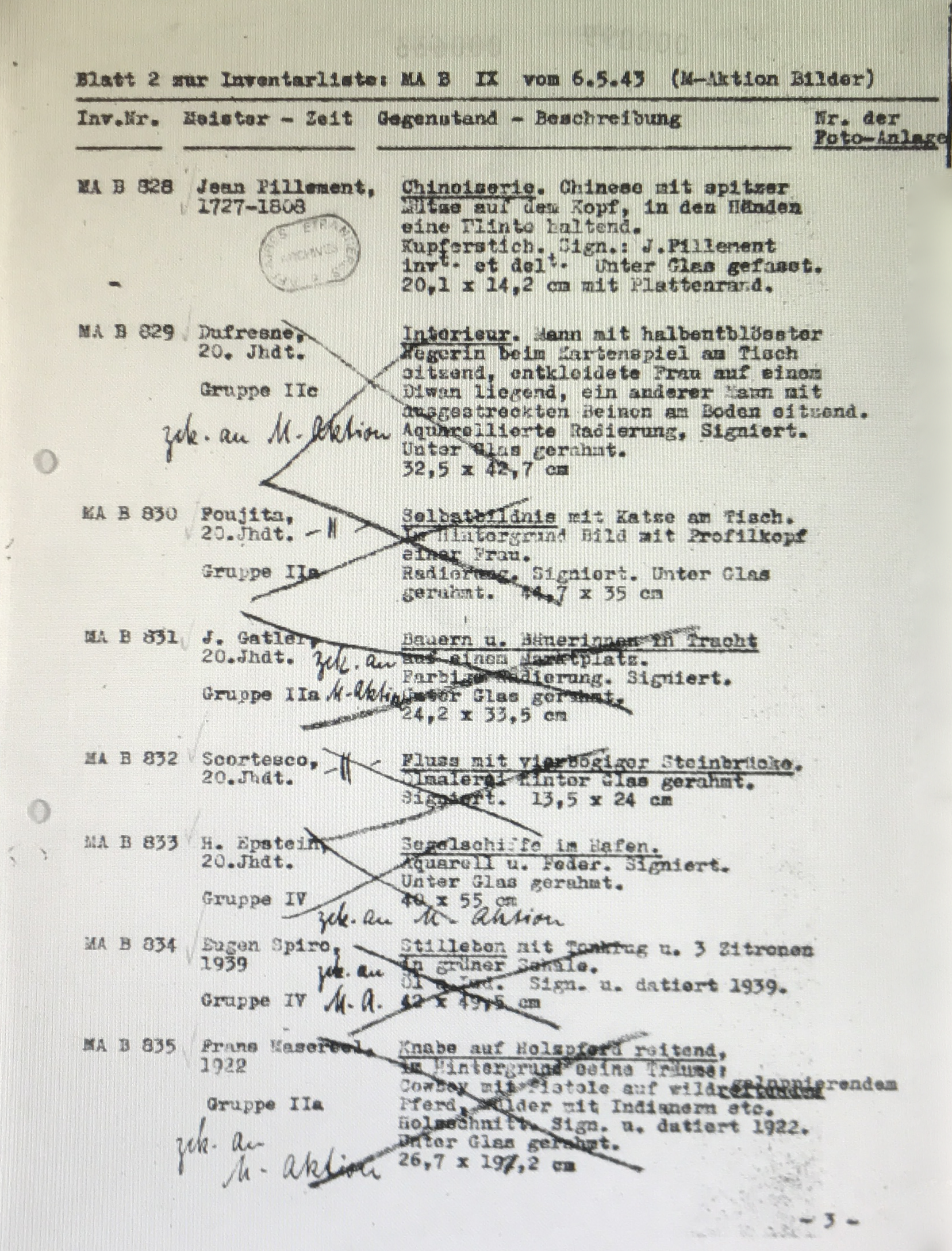
Fig 2: M-Aktion inventory list with notes „Zck. an M-Aktion“ (back to M-Aktion), 6 May 1943; Archives diplomatiques du ministère de l’Europe et des Affaires étrangères, La Courneuve, 209SUP/99/24.
It is noteworthy that almost all of those objects from the M-Aktion that the Nazis deemed saleable fall into one category: MA-B, that is pictures.15 It comprised paintings as well as works on paper. The majority were by French artists, and the period of creation most frequently the nineteenth century, followed by paintings and prints from the twentieth century. Yet sometimes, older works were selected: one object which surely must have surprised the looters of the Dienststelle Westen was an altarpiece, a triptych dated to the first half of the sixteenth century and originating from Italy or France.16 With regard to the general subject matter of works intended for sale, there were numerous innocuous genre scenes, still lifes and landscapes, which were very commercial. One of the most frequently appearing artists was for example the French landscape painter Henri Harpignies. His scenes of nature were part of the Barbizon school, whose modest, realistically painted and often small-scale landscapes had been successful even on the nineteenth century art market. In addition, the National Socialists considered copies after Old Masters to be sale material, while the originals were a particular target for their looting. However, these were only very rarely found in the course of the M-Aktion plunder, and most of all in the targeted looting of renowned collections of Jewish owners.
Considering the targeted looting of Jewish art collections that began immediately after the occupation, and the works that were confiscated, a particular characteristic is noticeable. Even among the art works explicitly confiscated from private collections, a number of objects was marked separately in order to be passed on for sale at a later stage. These items were annotated as “Zck. an M.-A. zum Verkauf” (fig. 3). It follows that these art works were meant to be passed to the M-Aktion even though they had not been confiscated as a result of the M-Aktion, with the objective of channelling them into the art trade.
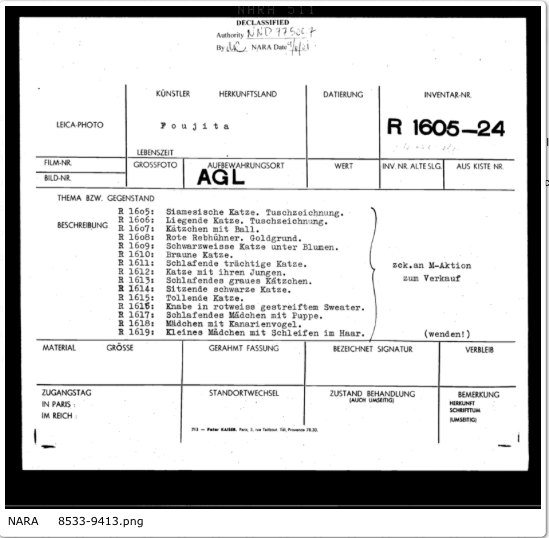
Fig. 3: ERR-card of works designated for sale from the Rothschild collection
National Archives and Records Administration, Washington, D.C., 8513-9413 via https://www.errproject.org/jeudepaume/card_view.php?CardId=8535 (accessed on 22 January 2018).
First of all, the large number of such objects is striking. There are over 730 works designated for sale from confiscated art collections, compared to just about 320, less than half, from the M-Aktion plunder. All were intended for the same purpose. Bearing in mind that over 5,500 objects were looted from important collections such as Rothschild alone, such an amount is hardly surprising. Nevertheless, the selection of works for sale from private collections differs slightly from that applied to the works from the M-Aktion: there were more paintings than works on paper in the first, while the categories were equally represented in the latter.
A particularly large group of objects among those intended for a sale transfer to the M-Aktion from private owners came from the collection of the art dealer Paul Rosenberg, who had represented many avant-garde artists in his famous gallery in Rue de la Boétie. Works from the twentieth century dominated the selection, unlike in the saleable works selected from the M-Aktion plunder, which had a stronger focus on the nineteenth century. In general, private owners seemed to gravitate more towards older, more established art to decorate their homes, and less to the contemporary art of their period. However, the surplus of twentieth-century works was also related to the fact that targeted looting had included confiscations in several studios and collections of artists who had fled. One of the most important among them was that of Eugen Spiro, a German-born painter and printmaker who had studied in Munich.17 In 1935 he escaped from the Nazis, travelling first from Berlin to Paris in 1940 and later to the United States. The German occupiers emptied his Paris studio, and his art collection as well as approximately 150 of his own works were looted. While the Germans destroyed many of his works, two thirds of the group of pictures were destined for sale by the ERR via the M-Aktion.
Eugen Spiro was of Jewish descent, as were many of the artists whose works the German occupiers intended to channel into the art market via the M-Aktion. Among these were, for example, Moise Kisling, Chaim Soutine and Jules Pascin. Even Marc Chagall was represented with just under ten works – his art was anything but compatible with Nazi tastes, as several of his works had been exhibited at the exhibition of “Degenerate Art” in Munich in 1937. Clearly, the opportunity of turning a profit with art overruled ideological National Socialist reservations about works by Jewish artists. Alfred Rosenberg, head of the eponymous ERR, had published these reservations extensively in his main, anti-Semitic publication “Mythus des 20. Jahrhunderts” of 1930.18 In it, he juxtaposed Judaism and the Nordic race, while simply denying Jews any ability to create art at all. Furthermore, he accused Jews of being the near exclusive representatives of international finance. France was a particular bête noire for Rosenberg, since the country had supposedly made efforts to integrate Jews into French society since the times of the French Revolution. Consequently, one name keeps reappearing in Rosenberg’s book “Mythus” as a main object of his revulsion – that of the Jewish banking dynasty Rothschild.
The French Rothschild art collections were as extensive as they were valuable, and they were among the first private collections to be confiscated by the Germans after the occupation of Paris. An accurate financial valuation of the collection was impossible from the Nazi’s point of view, since “no comparable assets have appeared on the art market”.19 From the collection of this banking family, a total of 132 works were earmarked for sale via the M-Aktion, which makes the Rothschild provenance the most frequently listed private collection in this context – even though part of it had been confiscated two years before the M-Aktion even began.
The observation that works from confiscated private collections that were unrelated to the M-Aktion were marked for a “return” to the latter, in order to be sold together with objects from the other wave of plunder, casts a different light on the M-Aktion. Even without knowing details about the planned sale of these works, and without understanding why this consolidation took place, the concept designated by the name M-Aktion is now extended. Through being extended to works looted in other circumstances, it no longer refers to a specific plundering initiative. Rather, it becomes a more general term for a method of disposing of plundered objects on the art market, even if the exact details are unknown. However, it seems certain that the organising office of the M-Aktion, the Dienststelle Westen, would also have played a different part.
Since the confiscations of art works from Jewish collections by German occupiers in the Second World War began, such objects were also sold – even though this was not planned, apart from very few exceptions, and was officially denied. A letter from Göring, whose ambitious collection also included objects from the M-Aktion, to Alfred Rosenberg demonstrates the level of internal mutual mistrust. “I believe that your task force for recording cultural goods in Paris acquired the wrong reputation under you, as if it were dealing with art by itself”, the Reich marshal wrote to the head of the ERR in May 1942.20 During World War II, the Paris art market was more active than ever.21 Many buyers wished to invest in tangible assets during uncertain times and came in droves to the auction house Drouot, which achieved top profits, or commercial galleries. Many art dealers were Jewish, and their stock was sometimes offered under terms which clearly favoured the buyer. German private collectors and museum representatives flocked to the French capital, benefiting from an advantageous exchange rate, in order to enhance their collections of, for example, nineteenth-century art. Art dealers such as Walter Hofer or Josef Angerer, who scoured Paris for Old Masters for Göring’s collection or the planned museum of the “Führer” in Linz, came furnished with extensive budgets and did not hesitate to pay high prices.
The ERR reacted to the flourishing of the art market and adapted the organisation of its holdings: “Apart from those works whose value as art can be regarded as generally accepted and secure, a few hundred paintings by the so-called modern French painters were also seized, which cannot be regarded as valuable art from a German perspective, and which do not constitute desirable assets for German art holdings in line with the National Socialist concept of art. These works are listed separately, pending a later decision on a type of use. On the orders of the Reich marshal, a number of such modern and degenerate French art works were exchanged for paintings of recognised artistic value.”22
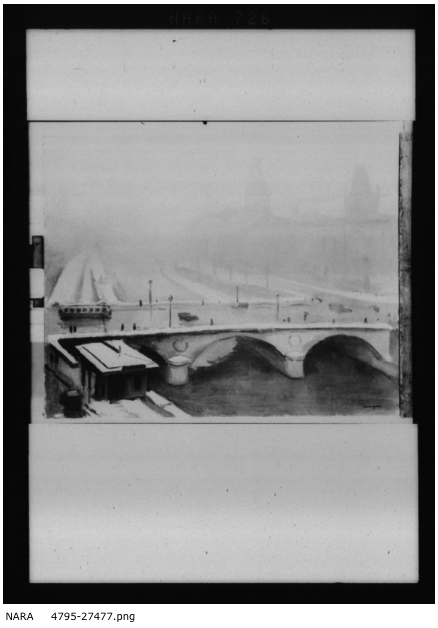
Fig. 4: Albert Marquet, Pont St. Michel, Paris, oil on canvas, 62 x 92 cm, whereabouts unknown, photo taken by the ERR
National Archives and Records Administration, Washington, D.C., 4795-27477 via https://www.errproject.org/jeudepaume/card_view.php?CardId=4795 (accessed on 22 January 2018).
A total of 230 paintings and works on paper which originated from the ERR holdings at the Jeu de Paume were destined for exchange. Modern works were handed to art dealers active in Paris who in turn acquired Old Master paintings, which were more in line with National Socialist doctrine. The dealer whose name featured most frequently in these exchanges was the German-born Gustav Rochlitz, who ran a commercial gallery near the Hôtel Drouot from 1933 onwards, which later moved to the Rue de Rivoli.23 In general, a small part of the works which were meant to reach the art market through exchanges came from the M-Aktion, but were not identical with works selected by the ERR for sale. Simply put, works destined for exchange were by more established artists with a higher market value than those intended for sale via the M-Aktion. For example, Henri Matisse and Auguste Renoir would be “exchange artists”, while works by artists such as Henri Harpignies, Marie Laurencin and Tsuguharu Foujita would be considered more suitable for sale. Sometimes, the division was not clear, however, and there were overlaps. For example, several works by the Fauve painter Albert Marquet that came from private collections and were destined for sale via the M-Aktion, were also discussed as potential exchange objects (fig. 4).24 Hand-written notes above the photographs of the paintings indicate the intention of passing them to the art dealer Martin Fabiani. Fabiani was of Corsican descent and was described in the American documents on art dealers who traded with the Germans as “adventurer, gigolo, and race track tout” (fig. 5).25 He had close contacts to the ERR. After the war he was sentenced as a collaborator but remained active as a dealer in modern art in Paris for many years, while writing his memoirs – without including any reference to dealing with looted art.26
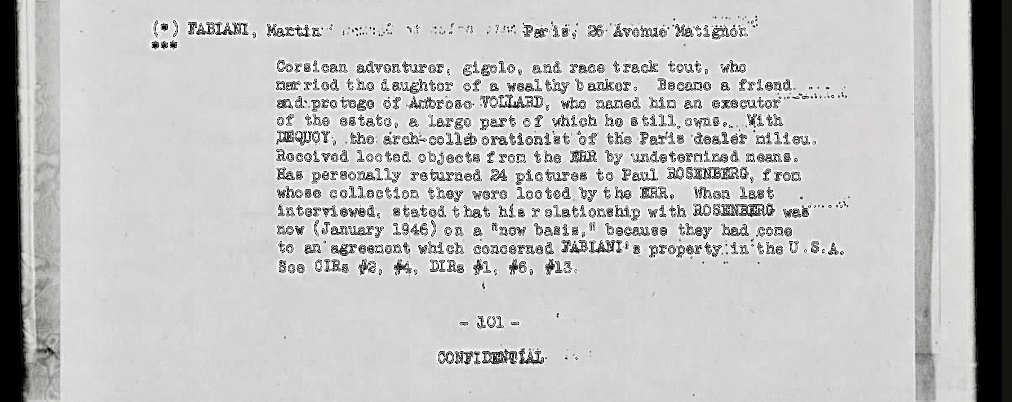
Fig. 5: Report on the art dealer Martin Fabiani, Art Looting Investigation Unit: Final Report, 1 May 1946, Washington, D.C., p. 110; National Archives and Records Administration, Washington, D.C., 1537311, Subject Files, compiled 1944-1946, documenting the period 1940-1946.
It is not clear for which exchange the works by Marquet were intended and whether this took place in the end. One planned exchange which was abandoned, that included paintings by Marquet, was a large scale coup in January 1944. Apart from Fabiani, the art dealer Roger Dequoy was also involved, who was closely connected to the Wildenstein gallery. A total of sixty works by modern artists were meant to have been exchanged with seven Old Master paintings (among others by Francesco Guardi, François Boucher/Hubert Robert) more suited to National Socialist taste. Rose Valland noted the details of the planned exchange.27 In the end, the plan failed because of a veto by Robert Scholz, the superior of Bruno Lohse, the deputy head of the ERR “Fine Arts” team. Lohse had been involved in the plan.28 It may have been this potentially lucrative exchange with a transaction value of two million francs for which the Marquet paintings were destined that had originally been marked for sale by the M-Aktion.
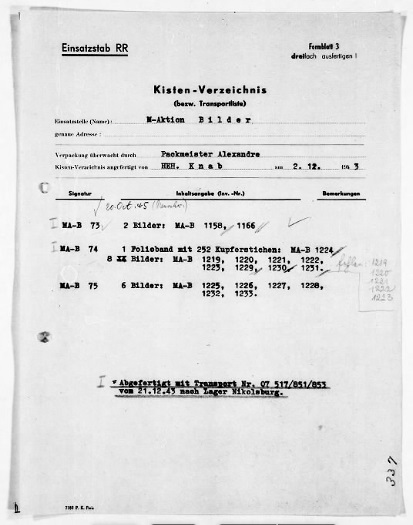
Fig. 6: ERR (France) shipping list to Nikolsburg, 12 December 1943; National Archives and Records Administration, Washington, D.C., A3389, Records Concerning the Central Collecting Points (“Ardelia Hall Collection”): Selected Microfilm Reproductions And Related Records, 1945-1949, roll 0010.
Another fact reported in 1943 in Rose Valland’s notes, which are such an important source for research, was the increasing lack of space which troubled the ERR in Paris. The holdings were rearranged again and again in order to decide which works were to be sent to Germany, thus creating space in Paris warehouses. The hand-written notes on the inventory lists, which release works for sale to the M-Aktion, date from the same time and may have been made as part of the redistribution effort.29 Art works seized during the M-Aktion were taken into storage in Schloss Seisenegg in Austria and Schloss Nikolsburg (now Mikulov in the Czech Republic), among others (fig. 6).30 For example, on 4 May 1944 a group of paintings, drawings and prints which had been seized during the M-Aktion, was taken to Nikolsburg, as Rose Valland’s notes confirm.31 After the war, the whereabouts of objects stored in Nikolsburg was particularly hard to track. Many objects vanished without trace, be it during a fire in the castle in 1945, be it through plundering.
Until today, it remains unclear how exactly the ERR had envisaged the sale of objects which were to be passed on to the art market via the M-Aktion: where and how the sale was to take place, in how far the office of the Dienststelle Westen was to be involved, etc. Since the selection also included works by Jewish artists, as demonstrated above, which could not have been traded officially in Germany, it may be assumed that all were destined for the flourishing and internationally more attuned French art market. While the documentation of art works marked for exchange by the ERR was often annotated with the name of Paris art dealers such as Fabiani, Dequoy or Rochlitz, who were meant to effect the exchange, notes about galleries or auction houses are missing entirely from the documents about works destined for sale. It seems likely that even the National Socialists themselves were not clear how to handle the works: “Once the entire initiative is concluded, a proposal will be put forward about the use of the remaining stock of modern, respectively degenerate, French art.”32 Spot checks demonstrate that art works which the Germans had confiscated from private collections and destined for sale via the M-Aktion, were only shipped to Germany at quite a late stage of the occupation. A large part of such works were on board the notorious Train d’Aulnay, that is train no. 40-044, which took five freight cars full of modern art works plundered from Jewish collections from Paris to Germany.33 Rose Valland succeeded in informing the director of the Louvre, Jacques Jaujard, about the planned transport, who in turn notified members of the Résistance. Through targeted sabotage, they managed to bring the train to a halt in Aulnay-sous-Bois north of Paris, where it was liberated by American troops on 27 August 1944.
As far as the owners could be traced, which was the case for numerous objects on the Train d’Aulnay, the art works seized by the National Socialists were returned to their rightful owners.34 Where objects confiscated by the Germans in France could not be restituted after the end of the war, these were handed to the French state. To date, it holds part of them, in case former owners or their descendants come forward.35 The remaining art works, including former M-Aktion objects, were sold between 1950 and 1953 at auction in Paris at the Salle des ventes des domaines, thus entering the art market, where some of them still circulate.
Gitta Ho is an art historian and provenance researcher associée at the Centre allemand d’histoire de l’art in Paris.
Translation: Susanne Meyer-Abich
1 On the M-Aktion see J. J. Jacobson, ed., M-Aktion. Frankreich, Belgien, Holland und Luxemburg. 1940-1944 ([Frankfurt a. M.:] United Restitution Organization (URO), 1958); Annette Wieviorka/Floriane Azoulay, Le pillage des appartements et son indemnisation/Mission d’étude sur la spoliation des Juifs de France (Paris: Mattéoli Mission, 2000); Jean-Marc Dreyfus/Sarah Gensburger, Des camps dans Paris. Austerlitz, Lévitan, Bassano juillet 1943-août 1944 (Paris: Éditions Fayard, 2003); Shannon L. Fogg, Stealing Home. Looting, Restitution, and Reconstructing Jewish Lives in France, 1942-1947 (Oxford and New York: Oxford University Press, 2017).
2 Here and hereafter this article refers to the Jeu de Paume database on www.errproject.org, which unites information from index cards on plundered works of art brought to the Jeu de Paume and the Louvre by the Germans with information from other archival sources such as the Bundesarchiv Koblenz or the Centre des Archives diplomatiques du ministère de l’Europe et des Affaires étrangères (hereafter referred to as MAEE) at La Courneuve.
3 Cf. Dreyfus/Gensburger, Des camps dans Paris, 307 remitting to Bericht über die Übernahme des Dienstgutes der Dienststelle Westen des Reichsministeriums für die besetzten Ostgebiete, Bundesarchiv, Koblenz, NS 9 230, 218. Several inventories (‘Wohnungsbefundbücher’) have been preserved with descriptions of plundered homes, cf. ibid., 263.
4 Telegram to the military commander in France (transcript), 8 February 1942, in ibid., 39.
5 Bericht über die Geschäftsprüfung der Dienststelle Westen [audit report about Dienststelle Westen], 15 September 1943, in ibid., 132-133.
6 Gesamtleistungsbericht der Dienststelle Westen bis zum 31. Juli 1944 (transcript of 8 August 1944), in Der Prozess gegen die Hauptkriegsverbrecher vor dem internationalen Militärgerichtshof. Nürnberg, 14. November 1945–1. Oktober 1947 (Nuremberg: Internationaler Militärgerichtshof, 1949, vol. 38), 32.
7 Der Prozess gegen die Hauptkriegsverbrecher, 26.
8 At times, the ERR was much behind when preparing the cards. For example, a report from 1943 mentions 9, 455 inventoried objects as well as 10,000 objects, which have not yet been inventoried and which are still to be inventoried after their transport to Germany, cf. Zwischenbericht über die Erfassung herrenlosen jüdischen Kunstbesitzes durch den Einsatzstab Reichsleiter Rosenberg in den besetzten Westgebieten, Berlin, 16 April 1943, in Jacobson, M-Aktion, 108-109.
9 Ibid., 107.
10 Sonderstab Bildende Kunst, Arbeitsbericht über die Zeit vom Oktober 1940 bis Juli 1944, in ibid., 177.
11 Abschluss-Bericht der Einsatzleitung Nordostfrankreich, 3-4, Bundesarchiv, Koblenz, NS 30, 12, quoted in Dreyfus/Gensburger, Des camps dans Paris, 62.
12 Office of Strategic Services/Art Looting Investigation Unit, Consolidated Interrogation Report No. 1. Activity of the Einsatzstab Reichsleiter Rosenberg in France, 15 August 1945 (Washington, DC: OSS, 1945).
13 For the Inventarlisten M-Aktion (Bilder) cf. MAEE, La Courneuve, 209SUP99/24 and 209SUP99/22.
14 In her notes, Rose Valland describes a large scale inspection of looted paintings taken from the storage facilities in the Jeu de Paume and in the Louvre, resulting in a division in several categories. Works that were considered saleable were listed separately. Many works not deemed to be of value were destroyed, cf. Emmanuelle Polack/Philippe Dagen, Les Carnets de Rose Valland. Le pillage des collections privées d’œuvres d’art en France durant la Seconde Guerre mondiale (Lyon: Fage Éditions, 2011), 78; Lynn H. Nicholas, The Rape of Europa. The Fate of Europe’s Treasures in the Third World and the Second World War (New York: Alfred A. Knopf, 1994), 170.
15 Only one work, a sculpture, was from the category MA-PL: https://www.errproject.org/jeudepaume/card_view.php?CardId=8813 (accessed on 22 January 2018).
16 Cf. MA-B 109: https://www.errproject.org/jeudepaume/card_view.php?CardId=50398 (accessed on 22 January 2018).
17 For Spiro cf. Wilko von Abercron, Eugen Spiro. Spiegel seines Jahrhunderts (Alsbach: Drachen-Verlag, 1990); Peter Spiro, Nur uns gibt es nicht wieder. Erinnerungen an meinen Vater Eugen Spiro, meine Vettern Balthus und Pierre Klossowski, die Zwanziger Jahre und das Exil (Hürth: Edition Memoria, 2010).
18 Alfred Rosenberg, Mythus des 20. Jahrhunderts (Munich: Hoheneichen, 1930).
19 Sonderstab Bildende Kunst, Arbeitsbericht über die Zeit von Oktober 1940 bis Juli 1944, in Jacobson, M-Aktion, 178.
20 Letter from Hermann Göring to Alfred Rosenberg, 30 May 1942, in ibid., 64.
21 Laurence Bertrand-Dorléac, Le marché de l’art à Paris sous l’Occupation, in Robert Fohr/Guillaume de La Broise, ed., Pillages et restitutions. Le destin des oeuvres d’art sorties de France pendant la Seconde guerre mondiale (Paris: Éditions Adam Biro, 1997), 89-96.
22 Zwischenbericht, 1943, in Jacobson, M-Aktion, 110.
23 Office of Strategic Services/Art Looting Investigation Unit, Detailed Interrogation Report No. 6, 15 August 1945, subject: Gustav Rochlitz (Washington, DC: OSS, 1945), 5-7.
24 Cf. Inventory numbers Braun 2, Braun 3, Braun 4, Braun 9, Meyer 6, KAP 1, Loewell 13, CLE 5 on www.errproject.org.
25 War Department, Strategic Services Unit, Art Looting Investigation Unit Final Report, 1 May 1946 (Washington, DC: OSS, 1946), 110.
26 Martin Fabiani, Quand j’étais marchand de tableaux (Paris: Julliard, 1976).
27 Polack/Dagen, Les carnets de Rose Valland, 88.
28 Office of Strategic Services/Art Looting Investigation Unit, Detailed Interrogation Report No. 6, 15 August 1945, subject: Bruno Lohse (Washington, DC: OSS, 1945), 11. The Report gives no reasons why the exchange was abandoned.
29 The handwritten notes, all written by the same handwriting and probably all written at the same time, can be found on M-Aktion (Bilder) inventory lists until 7 July 1943, cf. MAEE, La Courneuve, 209SUP99/24.
30 For inventories and crate lists of transports to Schloss Seisenegg cf. Bundesarchiv, Koblenz, B323/302.
31 Polack/Dagen, Les carnets de Rose Valland, 92-93.
32 Zwischenbericht, 1943, in Jacobson, M-Aktion, 110.
33 Cf. Inventaire des caisses récupérées dans le train 40044, MAEE, La Courneuve, 209SUP/296.
34 This is especially true for renowned art collections such as the one Paul Rosenberg, for example, where the owner’s name was often marked on the packing crates by the ERR.
35 Cf. Isabelle Le Masne de Chermont/Didier Schulmann, Le pillage en France pendant l’Occupation et la situation de 2000 œuvres confiées aux musées nationaux (Paris: Mattéoli Mission, 2000), 53-74 and the database http://www.culture.gouv.fr/documentation/mnr/pres.htm (accessed on 22 January 2018).